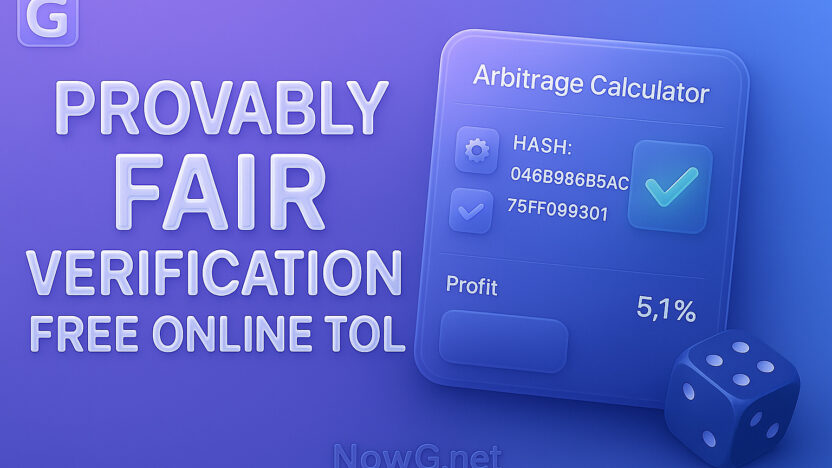Last Updated on October 27, 2025 by Caesar Fikson
A provably fair verification tool is suitable for users who can enter a game’s server seed and client seed to verify shuffle fairness; this appeals to crypto‑casino players and builds authority in blockchain gaming.
Provably Fair Verification Free Tool
Provably Fair Verification (HMAC-SHA256):
Verify Seeds, Reproduce Results, Prove Integrity

This page lets players, reviewers, and compliance teams verify provably fair games by checking the server seed commit (SHA-256), combining it with the client seed and nonce, and recomputing the outcome. No black boxes, no vibes—just deterministic HMAC-SHA256 and reproducible RNG.
What “provably fair” actually means
- Server seed commit (pre-game): the operator publishes SHA-256 hash of a secret server seed.
- Play: outcome is derived from HMAC-SHA256(server_seed, pattern(client_seed, nonce)).
- Reveal (post-game): the operator discloses the server seed; the commit must match.
- Verification: anyone can reproduce results with the same inputs. If it doesn’t match, it’s not fair.
Tags: provably fair casino, HMAC-SHA256 commit, server seed reveal, client seed, nonce, deterministic RNG, fairness verification tool.
Supported games & output ranges
| Game | Source of randomness | Output range | Notes |
|---|---|---|---|
| Dice | Unbiased ints from HMAC stream | 0–99 or 0–99.99 | Precision selectable. |
| Roulette (EU) | Unbiased int mod 37 | 0–36 | Single zero wheel. |
| Roulette (US) | Unbiased int mod 38 | 0–36 + 00 | 37 maps to “00”. |
| Crash (generic) | First 52 bits → r; mult=(1−edge)/(1−r) | ≥ 1.00× | Edge and decimals configurable. |
| Card Shuffle | Deterministic Fisher–Yates | 52-card permutation | Output top N cards. |
How to verify (step-by-step)
- Paste server seed (revealed) and the commit hash supplied before play.
- Paste client seed and starting nonce; choose round count.
- Pick the game. Adjust precision/edge if relevant.
- Click Verify & Generate.
- Compare the tool’s results to the operator’s game log. Commit must match and round outputs must align exactly.
Why the commit matters
Without a pre-committed hash, the operator could swap server seeds post-facto to fit favorable outcomes. A SHA-256 commit → reveal guarantees precommitment: the revealed seed either hashes to the original commit (honest) or it doesn’t (caught).
Security model: what’s guaranteed (and what isn’t)
- Guaranteed: No post-game tampering if the commit matches and outcomes recompute bit-for-bit.
- Not guaranteed: payout policies, RTP, rounding rules, third-party integrations, or off-chain salts an operator didn’t publish. Always verify the exact message pattern (e.g.,
{client}:{nonce}) and any salts the operator documents.
Common pitfalls
- Wrong message pattern (token order, separators).
- Using the wrong nonce (0-based vs 1-based).
- Comparing EU vs US roulette incorrectly (00 handling).
- Crash decimals/edge mismatched with house rules.
- Hex vs UTF-8 confusion for seeds (operators should use text seeds, not hex blobs—this tool expects UTF-8 strings).
Compliance & trust benefits
- Audit trail: Reproduce historical rounds for KYC/RG investigations.
- Dispute resolution: Cryptographic proof beats screenshots.
- Link-worthy resource: Affiliates and compliance blogs naturally cite provably fair verification pages with tools.
Troubleshooting checklist
- Does
SHA256(server_seed)equal the published commit? - Is your client seed identical (case/whitespace)?
- Is the nonce the same as in the game log?
- Does the message pattern match the operator’s spec?
- For batch rounds, do results align round-by-round?
FAQ (for rich snippets)
What is a provably fair commit hash?
A SHA-256 hash of the server seed is published before play. It proves the seed existed and couldn’t be changed later without breaking the hash.
Which hash/HMAC does this tool use?
SHA-256 for commits and HMAC-SHA256 (server seed as key) for per-round randomness—an industry-standard approach.
Can I verify crash multipliers?
Yes. The tool derives r from the first 52 bits of HMAC output and computes mult = (1 − edge) / (1 − r). Configure house edge and decimals to match the operator.
What if an operator uses a different format?
Use “Advanced” to set the message pattern (e.g., {client}|{nonce}) and include any extra salts the operator documents.
Does this prove RTP?
No. It proves result integrity, not payout math. RTP is statistical and policy-dependent.




